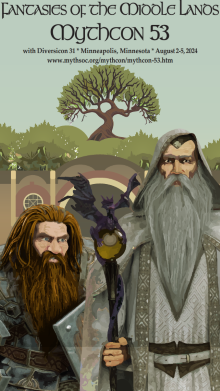Loading...
Event Website
Start Date
2-5-2022 1:30 PM
Description
Tolkien incorporates horror in his legendarium through the twisting of the natural world in order to signal upcoming dangers to his characters. This creates a dichotomy between the idyllic natural world that represents good in his works and the twisted natural world that has been tampered with by evil. Most of the focus on Tolkien’s portrayal of nature looks at the conflict between nature and technology; the natural world of Middle-earth is portrayed as more complex than merely all nature being good. His natural settings take on an eerie tone to convey a sense of horror to the reader as his characters are placed in greater danger. Examples of this can be seen in Thangorodrim, the Barrow-downs, and Mirkwood. In each of these settings the natural world has been corrupted by evil which poses a danger to the characters passing through. Thus, in contrast to settings like the Shire or Valinor, which are meant to reflect the “goodness” of nature, Tolkien also includes settings, such as the above examples, where nature has been twisted or no longer follows the natural order of the world. Tolkien’s use of horror in his worldbuilding is through the corruption of nature, turning what was intended to be good into something darker and more dangerous.
Creative Commons License

This work is licensed under a Creative Commons Attribution-NonCommercial-No Derivative Works 4.0 International License.
Included in
Children's and Young Adult Literature Commons, Comparative Literature Commons, Digital Humanities Commons, European Languages and Societies Commons, Literature in English, Anglophone outside British Isles and North America Commons, Literature in English, British Isles Commons, Literature in English, North America, Ethnic and Cultural Minority Commons, Medieval Studies Commons, Modern Languages Commons, Modern Literature Commons, Other English Language and Literature Commons
Nature and Horror in Tolkien’s Legendarium
Tolkien incorporates horror in his legendarium through the twisting of the natural world in order to signal upcoming dangers to his characters. This creates a dichotomy between the idyllic natural world that represents good in his works and the twisted natural world that has been tampered with by evil. Most of the focus on Tolkien’s portrayal of nature looks at the conflict between nature and technology; the natural world of Middle-earth is portrayed as more complex than merely all nature being good. His natural settings take on an eerie tone to convey a sense of horror to the reader as his characters are placed in greater danger. Examples of this can be seen in Thangorodrim, the Barrow-downs, and Mirkwood. In each of these settings the natural world has been corrupted by evil which poses a danger to the characters passing through. Thus, in contrast to settings like the Shire or Valinor, which are meant to reflect the “goodness” of nature, Tolkien also includes settings, such as the above examples, where nature has been twisted or no longer follows the natural order of the world. Tolkien’s use of horror in his worldbuilding is through the corruption of nature, turning what was intended to be good into something darker and more dangerous.



Comments
Host: Marc DiPaolo
Tech Mod: Tim Lenz
Julia Bowers is an undergraduate student at the College of William and Mary, studying classics with a concentration in classical archaeology. She was first introduced to Tolkien’s works as a child, starting with The Hobbit, and quickly made her way through the Legendarium and onto the works of the other Inklings. Julia continued to study the Inklings in college through a class on Tolkien and his circle, looking at the works through a more scholarly lens.